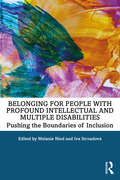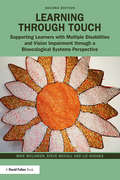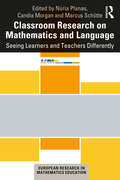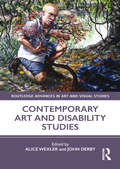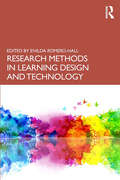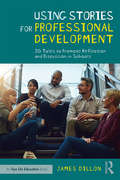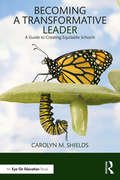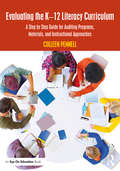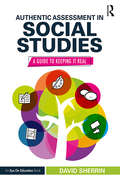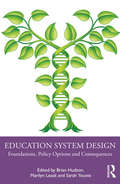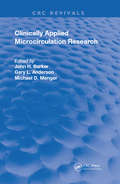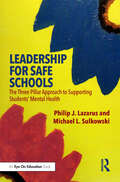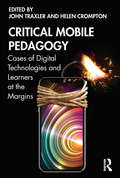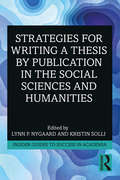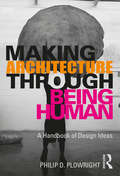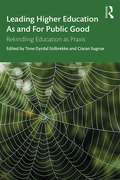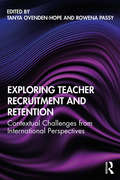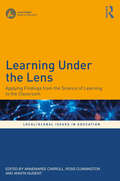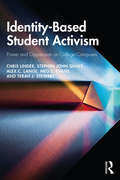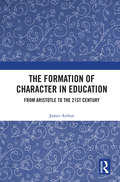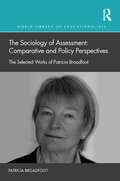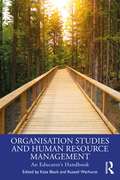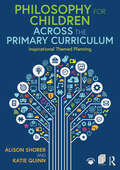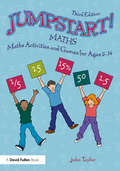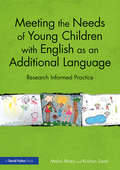- Table View
- List View
Belonging for People with Profound Intellectual and Multiple Disabilities: Pushing the Boundaries of Inclusion
by Melanie Nind Iva StrnadováThis book pushes the boundaries in the way we approach people with profound intellectual and multiple disabilities, and in how we work with them in education and research. While it is grounded in diverse theoretical frameworks and disciplines, the book coheres around a commitment to seeing people with profound intellectual and multiple disabilities as equal citizens who belong in our classrooms, research projects and community lives. Each section covers policy contexts, key ideas and recent research. Featuring contributions from around the world, the book incorporates established and new voices, different disciplines and experiences. Additionally, it includes pieces from family members of people with profound intellectual and multiple disabilities. Divided into three parts, the book explores three main topics: Belonging in education Belonging in research Belonging in communities Belonging for People with Profound Intellectual and Multiple Disabilities is an invaluable resource for scholars, professionals and postgraduate research students with an interest in children or adults with profound intellectual and multiple disabilities.
Learning through Touch: Supporting Learners with Multiple Disabilities and Vision Impairment through a Bioecological Systems Perspective
by Mike Mclinden Steve Mccall Liz HodgesThis fully revised and updated second edition of Learning through Touch is essential reading for practitioners who support learners with multiple disabilities and vision impairment. These learners will rely on support from their learning partners throughout their education to mediate their learning experiences. The text explores the key role that touch plays in the education of these learners and provides practical advice about how to develop the skills through touch that they will need to become ‘active agents’ in their own development. The book reflects international initiatives that seek to ensure that people with disabilities have opportunities to take meaningful control within their learning and their lives. Key features include: Chapters that support curriculum access for learners with visual impairments; Reflections on up-to-date research studies and guidance for further reading throughout, allowing for a strong conceptual foundation for practice; Portfolio activities designed to help implement effective learning opportunities within your own practice. Written to assist teachers and other professionals who support children with visual impairment and additional difficulties, this text will appeal to professionals and students alike. It is an invaluable resource for anyone looking to explore the role of touch in creating effective learning experiences.
Classroom Research on Mathematics and Language: Seeing Learners and Teachers Differently (European Research in Mathematics Education)
by Núria Planas Candia Morgan Marcus SchütteThis book offers an international perspective on the current and future state of the research, focusing, in particular, on the role and use of language in mathematics school teaching and learning. It focuses on the development of a unified view of the languages of the learners, of the teachers and of mathematics by considering the role of language in the learning, teaching and doing of mathematics in the classroom, and the current richness and plurality of language and culture. The contributions in this volume combine to show how views of language and of language research in mathematics education have changed significantly in recent decades, and how they will continue to change and become even more complex and challenging in the era of diversity. All of these contributions by leading scholars are grouped into two sections for emphasis on issues of: • Theorising the complexity of language in mathematics teaching and learning • Opening spaces of learning with mathematics classroom research on language This book will be of great interest to mathematics teachers, teacher educators, curriculum developers and mathematics education researchers who deal with the study and implementation of pedagogies of mathematics teaching and learning, specifically in regions of the world which are culturally and sociolinguistically diverse.
Contemporary Art and Disability Studies (Routledge Advances in Art and Visual Studies)
by Alice Wexler John DerbyThis book presents interdisciplinary scholarship on art and visual culture that explores disability in terms of lived experience. It will expand critical disability studies scholarship on representation and embodiment, which is theoretically rich, but lacking in attention to art. It is organized in five thematic parts: methodologies of access, agency, and ethics in cultural institutions; the politics and ethics of collaboration; embodied representations of artists with disabilities in the visual and performing arts; negotiating the outsider art label; and first-person reflections on disability and artmaking. This volume will be of interest to scholars who study disability studies, art history, art education, gender studies, museum studies, and visual culture.
Research Methods in Learning Design and Technology
by Enilda Romero-HallResearch Methods in Learning Design and Technology explores the many forms, both new and established, that research takes within the field of instructional design and technology (IDT). Chapters by experienced IDT researchers address methodologies such as meta-analysis, social media research, user experience design research, eye-tracking research, and phenomenology, situating each approach within the broader context of how IDT research has evolved and continues to evolve over time. This comprehensive, up-to-date volume familiarizes graduate students, faculty, and instructional design practitioners with the full spectrum of approaches available for investigating the new and changing educational landscapes. The book also discusses the history and prospective future of research methodologies in the IDT field.
Using Stories for Professional Development: 35 Tales to Promote Reflection and Discussion in Schools
by James DillonThis book offers a selection of stories about teaching, learning, and school life that you can use in a variety of PD formats and settings. Grouped into four categories—students, teachers, administrators, and parents—these tales offer a powerful entry point for thinking and reflecting on your school environment in a new and meaningful way. Each brief tale is presented to spark a 10–15 minute group discussion that will help educators think more deeply about the complex, human problems they confront on a daily basis. Suggested questions and a brief commentary following each tale can be used to explore the issues embedded in the tale and, thereby, empower staff to generate creative responses to them. Ditch your "sit and get" professional development and "tap into the wisdom of the ages" by using these powerful tales to give educators the gift of time to think and talk about what it really means to educate hearts and minds.
Becoming a Transformative Leader: A Guide to Creating Equitable Schools
by Carolyn M. ShieldsThis exciting book explores the concept of transformative leadership and how leaders can create learning environments that are academically excellent, equitable, inclusive, and socially just. Grounded in research and real examples, Dr. Carolyn Shields presents an approach to leadership that is engaged, authentic, courageous, and effective in addressing the needs of today’s diverse student bodies. Featuring examples from schools and leaders, questions for reflection, downloadable eResources, and links to useful websites, Becoming a Transformative Leader is an invaluable and practical guide for school administrators, teacher leaders, and district leaders concerned about the uneven educational playing field for students in our schools.
Evaluating the K–12 Literacy Curriculum: A Step by Step Guide for Auditing Programs, Materials, and Instructional Approaches
by Colleen PennellAs your school district undertakes the process of evaluating its K–12 reading program, literacy curriculum, or literacy instructional practices, this book will be your go-to resource. Pennell offers a step-by-step guide for educators, school leaders, or professional learning communities to evaluate high-quality instructional materials and standards-aligned literacy practices. It includes a wealth of tools such as timelines, full meeting agendas, stakeholder surveys, and evaluation rubrics. Chapters cover key topics, including: Literacy leadership team meetings Reviewing foundational skills Comprehension and vocabulary Evaluating writing Selecting new materials Implementing new literacy materials Supporting educators through instructional coaching and professional learning Pennell provides a straightforward framework for how educators can work together collaboratively to analyze, reflect, and ultimately evaluate their school district’s literacy program. Each chapter is grounded in salient research on the why of literacy teaching and learning and helps you understand how instruction can be meaningfully aligned with current standards. The research and theory that support effective literacy instruction—including culturally responsive practices—are explained in an accessible and pragmatic manner. The practical tools in this book are essential for administrators and educators tasked with evaluating literacy programs and practices, as well as graduate students who must learn how to audit a literacy curriculum. Whether you’re a school administrator, teacher, or reading specialist, this book will ensure all your students can reach success in literacy.
Authentic Assessment in Social Studies: A Guide to Keeping it Real
by David SherrinThis engaging book will show you how to move beyond tests and essay writing to implement authentic assessments in your middle or high school social studies classroom. Award-winning teacher David Sherrin explains the value of authentic assessments and offers practical ways to get started and dive deeper in your own practice. You&’ll be encouraged and inspired by the real-life stories of classroom successes and failures that illustrate the points throughout the book. The chapters cover a range of categories, including different types of written, creative, and civic action assessments. The book includes: planning charts and rubrics showing how to use, grade, and give feedback on assessments so they truly aid student learning and progress specific examples, useful tips, and ready-to-go instructions that you can use immediately with your class open-ended assessments encourage scaffolding or adaptation for individual or group work to fit your classroom needs You will learn how to personalize instruction and provide students with avenues for creativity and the types of learning experiences they need to be prepared for a complex world.
Education System Design: Foundations, Policy Options and Consequences
by Brian Hudson Marilyn Leask Sarah YounieThis book highlights decisions governments have to make about their public education systems, the options they have before them and the consequences of their decisions. As well as covering issues such as values, curriculum, teacher training, structures and so on, the book addresses education planning for epidemics, pandemics and disasters. Education systems provide the foundations for the future wellbeing of every society, yet existing systems are a point of global concern. Education System Design is a response to debates in developing and developed countries about the characteristics of a high-quality national education service. It questions what makes a successful system of education. With chapters that draw on experience in education systems around the world, each one considers an element of a national education service and its role in providing a coherent and connected set of structures to ensure good education for all members of society. Key topics include: Existing education systems and what a future system might look like Inclusion and social justice Leadership and teacher education Policy options, and the consequences of policy changes This book suggests an education system be viewed as an ecosystem with interdependencies between many different components needing to be considered when change is contemplated. It is a vital book for any stakeholders in educational systems including students, teachers and senior leaders. It would be particularly useful to policy makers and those implementing policy changes.
Clinically Applied Microcirculation Research (Routledge Revivals)
by John H. Barker, Gary L. Anderson and Michael D. MengerFirst published in 1995: Clinically Applied Microcirculation Research combines state-of-the-art microcirculation technology with present and potential applications in clinical medicine. This comprehensive guide unites the expertise of clinicians and basic researchers from around the world. Many of the chapters are authored by scientist/physician teams. The book provides a broad overview of how microcirculation is involved in clinical research. This is also a valuable reference source for both the history of and latest developments in microcirculation research.
Leadership for Safe Schools: The Three Pillar Approach to Supporting Students’ Mental Health
by Philip J. Lazarus Michael L. SulkowskiLeadership for Safe Schools is every school and district leader’s guide to developing practical policies and carefully designed action plans to ensure that K–12 students are physically and psychologically safe, secure, and supported. With today’s students experiencing soaring rates of depression, anxiety, trauma, loneliness, and suicidality—in addition to the effects of the COVID-19 pandemic and the normalization of school shootings—school personnel desperately need multifaceted approaches that decrease violence, facilitate social connectedness, and promote emotional well-being. This book’s proactive, preventive, and responsive Three Pillar Model offers a coherent framework for creating safe and supportive schools and fostering student mental health. Each chapter guides school leaders and administrators to implement evidence-based interventions and strategies, including: strategies for school safety, threat assessment, suicide prevention, and anti-violence efforts easy-to-apply improvements to school climate and culture social supports for diverse students, including the marginalized, victimized, and at-risk effective partnerships with families, communities, and other spheres of influence principles from positive psychology and social-emotional learning research-based strategies for trauma-informed care and crisis response Whether you are a principal or superintendent; a school psychologist, counselor, or social worker; or a school resource officer, nurse, or proactive teacher, this book will be your all-in-one inspiration for fostering resilient learning environments and implementing multi-component prevention and intervention strategies to support students’ mental health.
Critical Mobile Pedagogy: Cases of Digital Technologies and Learners at the Margins
by John Traxler and Helen CromptonCritical Mobile Pedagogy is an exploration of mobile technologies for designing and delivering equitable and empowering education around the globe. Synthesizing a diverse range of projects and conceptual frameworks, this case-based collection addresses the ambitions, assumptions, and impacts of interventions in under-researched, often disadvantaged communities. The editors and authors provide a nuanced and culturally responsive approach to showcasing: indigenous, nomadic, refugee, rural, and other marginalized communities emerging pedagogies such as curation, open resources, massive open online courses (MOOCs), and self-directed learning contextual factors, including pedagogy, ethics, scaling, research methodology and culture, and consequences of innocuous or harmful implementation and deployment the nature of participation by global capital, multinationals, education systems, international agencies, national governments, and telecoms companies. Scholars, academics, policymakers, and program managers are increasingly using mobile technologies to support disadvantaged or disempowered communities in learning more effectively and appropriately. This book’s diverse research precedents will help these and other stakeholders meet the challenges and opportunities of our complex, increasingly connected world and work with greater cultural and ethical sensitivity at the intersection of education, research, and technology.
Strategies for Writing a Thesis by Publication in the Social Sciences and Humanities (Insider Guides to Success in Academia)
by Lynn P. Nygaard Kristin SolliResponding to the growing popularity of the thesis by publication within doctoral education, this book offers practical advice and critical discussion of some of the central choices and challenges that PhD students considering dissertation options face. Drawing on current research and informed by extensive experience of working with and running workshops for PhD candidates who write article-based dissertations, this book gives readers an idea of what writing a thesis by publication entails – what its purpose is, what the various expectations might be for this emerging genre, and what the challenges might be in writing one. Particular emphasis is put on how to put the individual articles together to create a coherent thesis that clarifies the student’s individual original contribution. Written primarily for students, Strategies for Writing a Thesis by Publication in the Social Sciences and Humanities covers key topics such as: how the genre has developed, with an emphasis on the role of the narrative (introductory text) that accompanies the articles typical rhetorical challenges that writers of such dissertations face strategies for handling the writing process specific challenges of demonstrating doctorateness in the thesis by publication and strategies for addressing them institutional variations that the thesis writer should seek clarification on as early as possible structural elements of the narrative and their main functions the range of choices that can be made throughout the doctoral journey and thesis writing. This book is a must-read for PhD candidates and supervisors new to the genre, as well as those involved in directing PhD programmes who are interested in the pedagogical implications of the move towards article-based dissertations.
Making Architecture Through Being Human: A Handbook of Design Ideas
by Philip D. PlowrightArchitecture can seem complicated, mysterious or even ill-defined, especially to a student being introduced to architectural ideas for the first time. One way to approach architecture is simply as the design of human environments. When we consider architecture in this way, there is a good place to start – ourselves. Our engagement in our environment has shaped the way we think which we, in turn, use to then shape that environment. It is from this foundation that we produce meaning, make sense of our surroundings, structure relationships and even frame more complex and abstract ideas. This is the start of architectural design. Making Architecture Through Being Human is a reference book that presents 51 concepts, notions, ideas and actions that are fundamental to human thinking and how we interpret the environment around us. The book focuses on the application of these ideas by architectural designers to produce meaningful spaces that make sense to people. Each idea is isolated for clarity in the manner of a dictionary with short and concise definitions, examples and illustrations. They are organized in five sections of increasing complexity or changing focus. While many of the entries might be familiar to the reader, they are presented here as instances of a larger system of human thinking rather than simply graphic or formal principles. The cognitive approach to these design ideas allows a designer to understand the greater context and application when aligned with their own purpose or intentions.
Leading Higher Education As and For Public Good: Rekindling Education as Praxis
by Tone Drydal Solbrekke Ciaran SugrueLeading Higher Education As and For Public Good asserts that the purpose of higher education is twofold: for public good and as public good. Acknowledging that the notion of public good increasingly cannot be taken for granted, the book argues that leading, teaching and learning must be directly connected to its pursuit. It avers and demonstrates how this may be accomplished, articulating specific approaches and dispositions that require cultivation within university communities. This volume argues that leading higher education occurs within competing and sometimes conflicting webs of commitments, necessitating a capacity to negotiate legitimate compromises. Its empirical chapters expand on this, providing examples of academic developers who use deliberate communication as a method in cultivating leading and teaching praxis. What emerges is the potential of deliberative leadership to be transformative in building sustainable leadership in higher education, while simultaneously renewing commitments to education and contributing to public good. Leading Higher Education As and For Public Good is essential reading for policy-makers, university leaders and administrators, academics, students and all those interested in building a sustainable future for higher education that also contributes to public good.
Exploring Teacher Recruitment and Retention: Contextual Challenges from International Perspectives
by Tanya Ovenden-Hope Rowena PassyThis thought-provoking collection examines the challenge of teacher shortages that is of international concern. It presents multiple perspectives, and explores the commonalities and differences in approaches from around the world to understand possible solutions for the current teacher workforce crisis. Acknowledging that solutions to attract and retain teachers vary by country, region and in some cases locality, the contributors scrutinise a range of workforce planning interventions at local and government level, including financial incentives and early career support. The book draws on different perspectives to understand a range of problems that negatively affect teacher recruitment and retention, unpicking key challenges, including links between the disadvantages of location and access to teachers for coastal and rural schools, rising pupil numbers, declining school budgets and the role of professional learning in raising teacher status. Abundant in critiques, research-informed positions and context-specific discussions about the impact of teacher workforce supply and shortages, this book will be valuable reading for teacher educators, educational leaders, education policy makers and academics in the field.
Learning Under the Lens: Applying Findings from the Science of Learning to the Classroom (Local/Global Issues in Education)
by Annemaree Carroll Ross Cunnington Annita NugentLearning Under the Lens: Applying Findings from the Science of Learning to the Classroom highlights the innovative approach being undertaken by researchers from the disparate fields of neuroscience, education and psychology working together to gain a better understanding of how we learn, and its potential to impact student learning outcomes. The book is structured in four parts: ‘Science of learning: a policy perspective’ sets the scene for this emerging field of research; ‘Self regulation of learning’ and ‘Technology and learning’ feature findings by eminent international and national researchers in the field and provides an insight into some of the innovative research illustrating the depth, breadth and multi-disciplinarity of the research; and ‘Research translation’ focuses on the scaled-up implementation of research findings in authentic learning settings, and showcases research findings which are having impact in learning environments. This fascinating book is intended as a reference tool to create awareness among researchers, policy makers, and education practitioners of the research being undertaken in the science of learning field and its potential to impact student learning outcomes.
Identity-Based Student Activism: Power and Oppression on College Campuses
by Chris Linder Stephen John Quaye Alex C. Lange Meg E. Evans Terah J. StewartHistorically and contemporarily, student activists have worked to address oppression on college and university campuses. This book explores the experiences of students engaged in identity-based activism today as it relates to racism, sexism, homophobia, transphobia, ableism, and other forms of oppression. Grounded by a national study on student activism and the authors’ combined 40 years of experience working in higher education, Identity-Based Student Activism uses a critical, power-conscious lens to unpack the history of identity-based activism, relationships between activists and administrators, and student activism as labor. This book provides an opportunity for administrators, educators, faculty, and student activists to reflect on their current ideas and behaviors around activism and consider new ways for improving their relationships with each other, and ultimately, their campus climates.
The Formation of Character in Education: From Aristotle to the 21st Century
by James ArthurThe Formation of Character: From Aristotle to the 21st Century offers an introduction to the foundations, practices, policies and issues of character formation historically. Following a chronological order, it charts the idea of character formation in the Western tradition by critically examining its precursors, origins, development, meanings and uses. The book is based on the premise that current conditions and debates around character formation cannot be fully understood without knowledge of the historical background. It introduces many of the debates character formation has generated in order to offer different perspectives and possibilities and uses Aristotle as a lens to gain a better understanding of some of these positions, particularly the theoretical goals of character formation. Chapters explore character education from the classical period through the medieval, early modern, enlightenment and Victorian eras to 20th century influences, ending with a discussion of contemporary policies and themes relating to character education. This book will appeal to academics, researchers, and post-graduate students in the fields of character and virtue education as well as the history of education.
The Sociology of Assessment: The Selected Works of Patricia Broadfoot
by Patricia BroadfootIn the World Library of Educationalists series, international experts themselves compile career-long collections of what they judge to be their finest pieces – extracts from books, key articles, salient research findings, major theoretical and practical contributions – so the world can read them in a single manageable volume. Readers will be able to follow the themes and strands and see how their work contributes to the development of the field. In a collection of her most influential work spanning nearly four decades, Patricia Broadfoot applies her trademark sociological and comparative perspective to empirical studies at every level of the educational system. From her classic long-term study of the impact of changing national assessment policies on pupils and teachers in the classrooms of England and France to her sustained championship of the need for a better understanding of the impact of assessment on learning, Broadfoot has consistently championed the need for a more developed sociological understanding of assessment. Broadfoot’s accessible writing offers insights that are as novel as they are important for the education of future generations. This book allows readers to follow themes and strands across Patricia Broadfoot’s career and will be of interest to all followers of her work and any reader interested in the development of teaching, learning and assessment.
Organisation Studies and Human Resource Management: An Educator's Handbook
by Kate Black Russell WarhurstThis book advances educational understanding and practice in Organisation Studies and Human Resource Management (OSHRM). It develops new theoretical perspectives on learning in OSHRM and introduces and evaluates a range of educational approaches, methods and techniques to advance teaching and assessment and student learning in the field. Chapters are evidence-based and provide practical advice for enhancing the effectiveness of OSHRM programmes and courses in universities, colleges and human resource development settings globally. With contributions from leading educators in OSHRM, the book both advances understanding and provides practical guidance for the design of programmes, courses and classes. Importantly, it illustrates innovative classroom and virtual learning experiences that will secure student engagement; cultivate critical and creative thinking; and enhance students’ employability, leadership and enterprise capabilities. A distinctive contribution of the book lies in the inclusion of student viewpoints on the understandings and educational advances proposed by the authors. Significantly, the book demonstrates how recent changes affecting higher education, such as globalisation, mass participation and marketisation, and, most recently, the pandemic crisis, can be embraced as opportunities to advance both educational understanding and educational policy and practice in OSHRM. This book will be invaluable for university educators internationally in the fields of OSHRM and for HR developers working in management and leadership development, and the book has relevance to both groups whatever their career stage, from absolute beginners through to advanced practitioners.
Philosophy for Children Across the Primary Curriculum: Inspirational Themed Planning
by Alison Shorer Katie QuinnThis is an easy-to-use, theme-based resource book for Philosophy for Children (P4C) practitioners in primary school settings. It covers ten popular themes which include many current affair issues and enduring curriculum themes such as artificial intelligence, biodiversity, resilience, and waste.Each theme provides planning for every subject and links to the relevant English national curriculum expectations. Offering ideas for a year’s worth of work, it can be dipped into for inspiration or used for step-by-step sessions. There are links to video clips, websites, and stories that teachers and practitioners can use to base their concept exploration and enquires on.Presenting a range of philosophical ideas, activities, and resources, this book is essential for all primary P4C facilitators excited by embedding and exploring philosophy across the curriculum.
Jumpstart! Maths: Maths Activities and Games for Ages 5-14 (Jumpstart)
by John TaylorThis fully updated third edition of Jumpstart! Maths presents a collection of simple-to-use, multi-sensory games and activities which will jumpstart students’ understanding of mathematics in action. It will help students to explore and learn maths both through technology and without, in an atmosphere of fun, mutual support and tolerance. With ten new activities and a digital hints and tips section, this book: follows and explores the national mathematics curriculum; promotes creativity in maths through practical activities that teachers can employ in their classrooms; provides a digital "hints and tips" section to integrate the use of digital teaching tools such as interactive whiteboards. Specifically written to help teachers work within the guidelines of the mathematics curriculum, this new edition brings into consideration the increasing presence of technology in education. If you are one of the thousands of teachers looking for a range of practical and fun ideas to teach maths engagingly, then this is the perfect book for you.
Meeting the Needs of Young Children with English as an Additional Language: Research Informed Practice
by Malini Mistry Krishan SoodDrawing on the latest research into how young children learn, this book considers how early years practitioners can best meet the needs of children with English as an Additional Language. It examines the factors that influence children’s learning including parents and the family, the environment, health and well-being, curriculum, play and relationships and aims to challenge misconceptions, assumptions and stereotypes. Featuring case studies and reflective questions, the chapters explore a range of important topics including: Language learning for children with EAL The historical concept and modern reconceptualisation of EAL How to develop and use Culturally Appropriate Pedagogy Regulation and performativity and their implications for children with EAL Leading learning for children with EAL Meeting the Needs of Young Children with English as an Additional Language is essential reading for students and practitioners wanting to promote an inclusive culture where different languages, cultures and religions are accepted and celebrated.
